It’s only two months into the school year, and teachers are exhausted. This year has made everyone, regardless of their years of experience, feel like a brand new teacher. Teachers are designing learning experiences for a range of learning landscapes. Some are navigating a hybrid schedule that blends synchronous in-class time with asynchronous online time. Others are teaching entirely online. And a growing number of teachers who began the year online are now shifting to the concurrent classroom where they are juggling the demands of teaching students both in class and online simultaneously.
In addition to feeling drained and overwhelmed, it may feel like there are not enough hours in the day to connect with students in a meaningful way. Yet, teachers and students need those touchpoints now more than ever. In my research, it was clear that the teachers’ relationships with their students significantly impacted their engagement at work. So, how do teachers create the time and space to connect and conference with individual students?
I’d like to propose using a creative strategy to free the teacher from needing to be “on” presenting information or orchestrating the lesson. If teachers design a “choose your path learning adventure,” students can enjoy some voice and choice in the experience and control the pace at which they process information and complete tasks.
Below are two options for creating a choose your path learning adventure. The first is a simple choice board format and the second is an interactive Google Slide deck.
Choose Your Path Learning Adventure Choice Board
First, teachers will want to select the topic to be the focus of this choice board. For example, an elementary teacher may want to focus on a specific season or weather pattern while a secondary teacher might focus on cell division or energy sustainability.
Next, teachers must organize the learning experience. I used the engage, explore, and explain progression for the choice board below. Students must select at least one activity from each column.
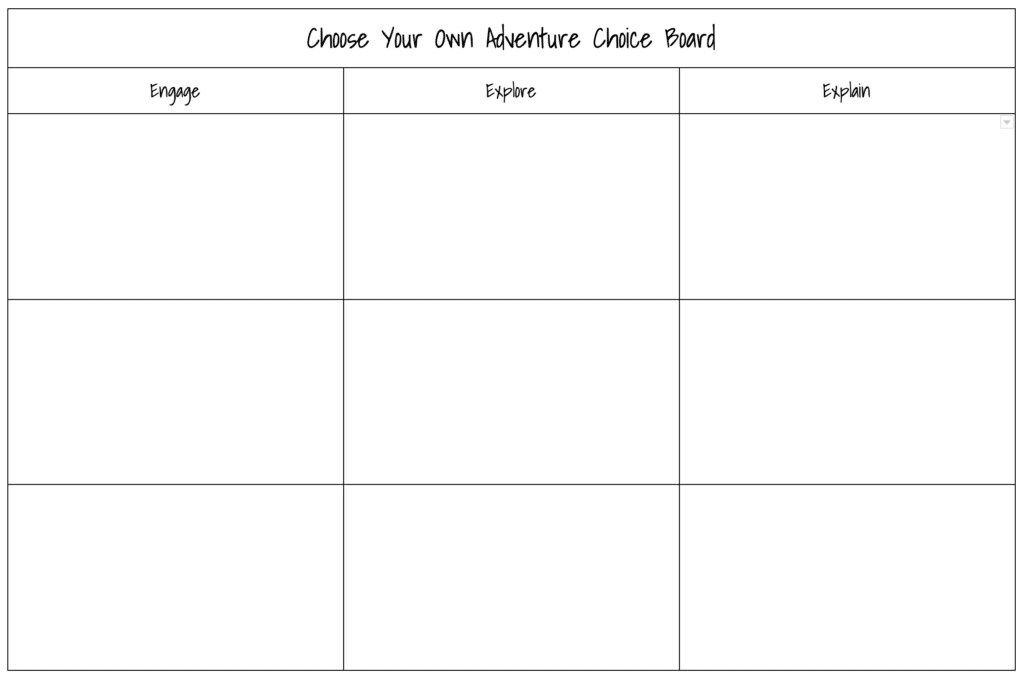
In the “engage” column, the goal is to provide students with three options to engage with information (e.g., texts, videos, audio recordings/podcasts).
The middle “explore” column is designed to encourage students to investigate, research, explore, and dig deeper into the topic. Teachers should consider offering both online and offline options in this column to give students a break from the screen. Perhaps they could conduct an interview with a family member, make observations in their backyards, tinker/build with recycled materials in their home.
The final column is the “explain” column should give students three different options for sharing what they learned during the engage and explore (e.g., produce a piece of writing, record a video explanation, create a flowchart or concept map, design a multimedia slide deck).
Below is a quick video tutorial walking you through the parts of this choice board.
Choose Your Path Learning Adventure Google Slide Deck
The second option I created to help teachers design a choose your path learning adventure is using the Google Slide deck below.
The second slide asks students, “How do you want to learn?” and asks them to select one strategy from each column. Once teachers make a copy of this template, they can click “View” at the top of their copy and select “Master.” Then they can hyperlink the images to online resources or digital document with directions
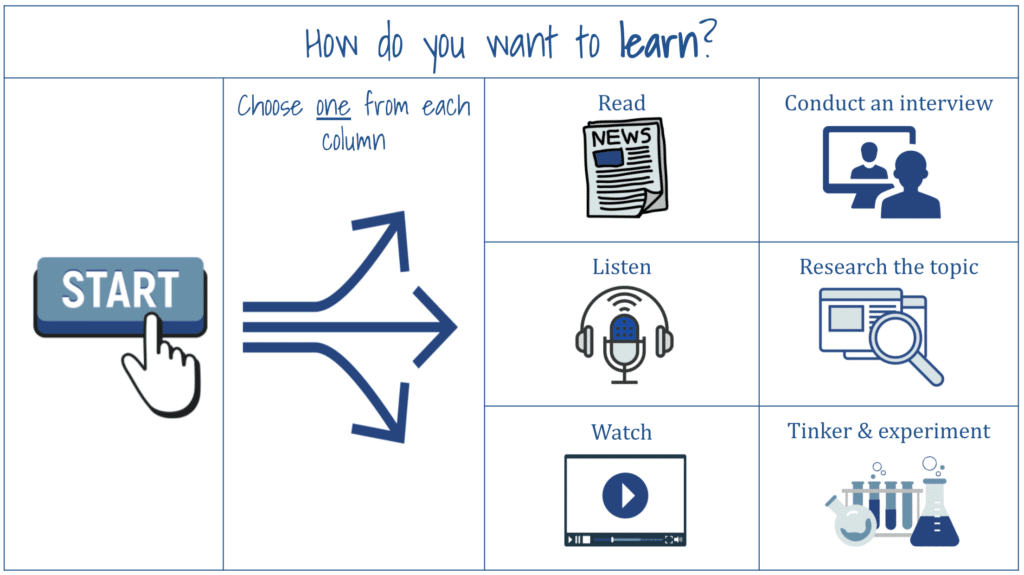
The third slide presents questions for students to consider and asks them to select a strategy to think about and process what they learned.
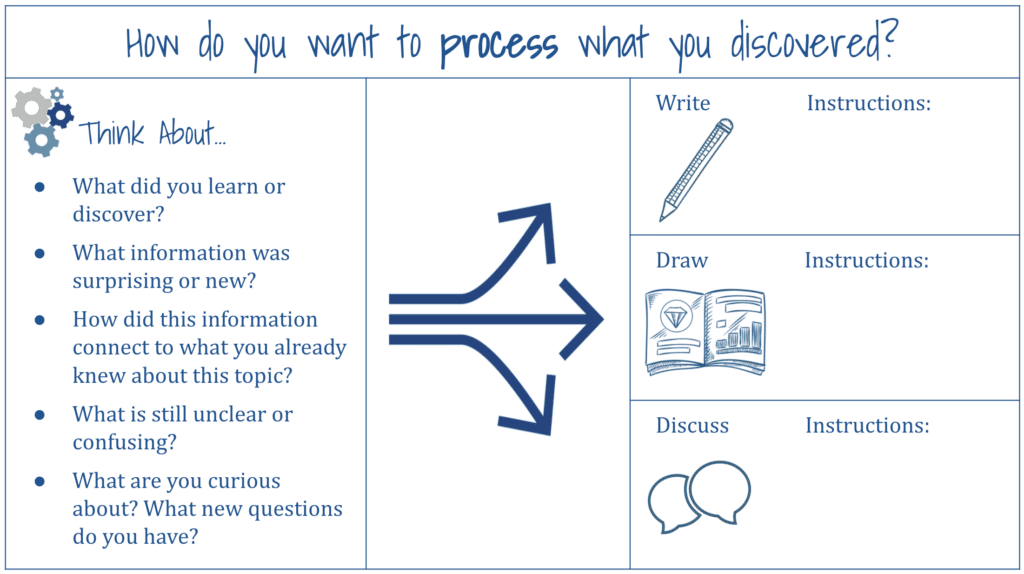
The fourth slide presents opportunities for students to practice. Teachers may want to have students review key concepts or vocabulary at this stage in the learning experience. I’d suggest providing a mix of online and offline options.
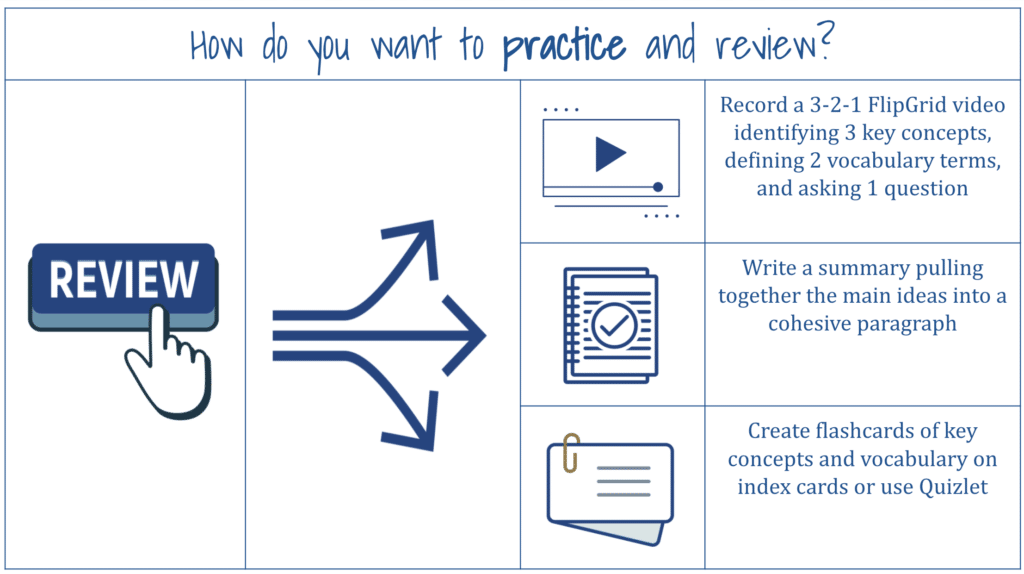
The fifth slide provides a range of strategies students can choose from to demonstrate their learning. As I said in an earlier blog about using the principles of Universal Design for Learning to guide the design of blended and online learning experiences, this choice allows students to select a strategy for communicating their ideas that is comfortable for them. It also yields a variety of products, which may be more interesting for teachers reviewing student work.
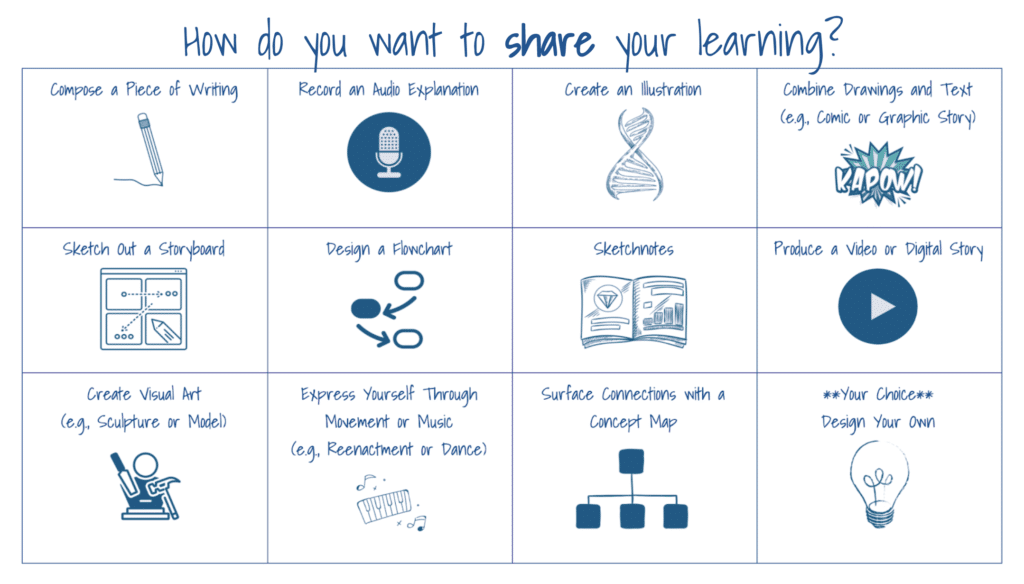
The sixth slide is where students will share what they created to demonstrate their learning. They can insert an image or video of their work, or they can type a written response on this slide. This makes the workflow more manageable for teachers. They can use Google Classroom to create an assignment and “make a copy” for each student. That way, students can document their learning in their slide deck, which is easier for teachers to access.
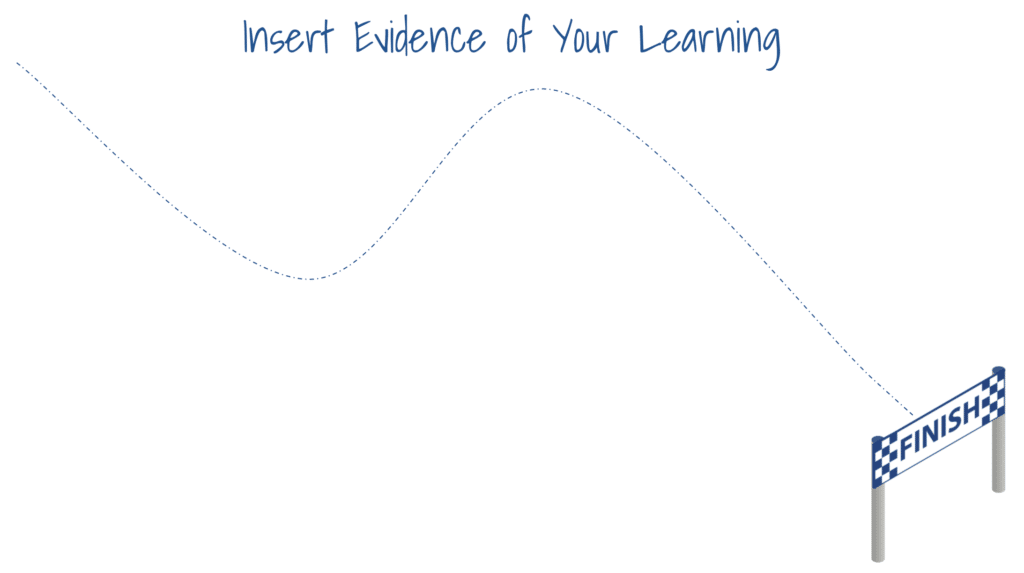
If teachers are “required” to have students in a synchronous session for a specific amount of time during the week, they can ask students to join the video conference but allow them to mute their mics and work. That way, teachers can pull individual students into a breakout room to check-in about progress, provide feedback on student work, or conduct a side-by-side assessment to grade an assignment that students have already completed.
Depending on the scope of the choose your path learning adventure, it could span a couple of days or a week. I hope this provides teachers with another strategy they can use to allow students to lead the learning AND create some time and space to connect with and support individual learners.


63 Responses
I think this is a really cool idea. I think giving students the choice allows them the opportunity to master the content but also have a say in how it’s done. Love love love. Thank you for sharing.
You’re welcome, Carrie! I always try to build student agency, or choice and voice, into learning experiences because it is the best way to engage and motivate students to lean into the learning.
Catlin
Thank you! This is an amazing mini-PD you have provided complete with any easy to follow template!
You’re welcome, Virginia!
Hello Sir, I’m a followers from Turkey. I’m working on argumentation in the flipped learning method. Should I do the discussion dimension offline or in the classroom?
Hi Cemal,
I would suggest using online discussions. Real-time, in-class conversations are often dominated by a handful of students. Online discussions (video-based with FlipGrid or text-based with your learning management system) will give every student a voice and the opportunity to share their ideas. Masks are also complicating real-time discussions in many classrooms.
Catlin
Thank you. Now, this I can use!!
I’m so glad, Debora!
Love this! I’m trying to figure a rubric that could address any product that students would create. Could you point me in a direction?
Hi Angie,
It depends on what the purpose of this choose your own adventure is. If you want to assess their comprehension of a topic or their ability to provide a clear, cogent overview of what they learned, you could create a one or two criteria rubric focused on assessing those skills. Otherwise, the content they are exploring during this choose your own adventure may be something that appears on an assessment in the future and may not need to be assessed independently.
Catlin
This is such a great idea as I have two grade levels this year in the same class. I can really utilize this for differentiation. Thank you. 🙂
You’re welcome, Leeah! I’m so glad you can use this to differentiate for the two grade levels in your class.
Take care.
Catlin
Thank you for the resource. I would like to use this in a PD about standard based grading and model the Choose Your Own Adventure strategy. I have found that so many of my teachers are at different levels of understanding with SBG, this would allow differentiation, choice and voice for teachers, which doesn’t happen very often.
This is really interesting to make learning more engaging experience. You have been an inspiration to me 🙂 to make learning process fun, engaging and pleasant experience.
Thank you, Fawwad! I appreciate your kind words. I’m so glad you are excited to try this to make learning fun and engaging!
Take care.
Catlin
This is perfect for what my colleagues and I are looking for to drive our inquiry through to our summatives. Thank you so much for sharing!
You’re welcome!
Very timely advice! I love your emphasis on how to continue to build relationships with students. Thank you for sharing!
You’re welcome, Hajira! 😊
Thank you, Catlin, for another amazing resource! I’m experimenting with your template by creating an example for teachers on how they might use this strategy to differentiate instruction, personalize learning, and engage students in more authentic ways. I’m also adding resource links to the slides so students can access scaffolds to assist them on this learning adventure!
Thank you!
Your welcome, Sonja! I’m thrilled you are using this template to create an example for your teachers.
Take care.
Catlin
Thank you for this template. I am a reading specialist trying to help classroom teachers with their load of work. Hopefully this will help them out. Once again, thanks!
You’re welcome, Myrna!
I created a couple models for my dept (Soc Stud), they really liked the format. I’m wondering if you have any suggestions on grading?
Hi Liz,
I would start by identifying your target standards and crafting the learning objectives for students. Then use those to create a rubric if you want to assess the work students do. If your rubric is standards-aligned, the product they decide to create won’t matter. You can use the same rubric for all students.
Catlin
The individual break-out rooms in video meetings have been very beneficial to student learning, especially this year. I recently had seven students quarantined at home and I frequently used synchronous sessions during my planning period to provide the same guidance and instruction that was being delivered to my in-person students. This allowed for the at-home students to ask questions, show me their work and progress, and allowed me to provide timely feedback to their completed assignments. Although they were at home, they felt included and less worried about “missing out” in class. In some instances, I used the break-out sessions to provided individual instruction to a student while the others continued working. This was a great tool to use during the difficult time for those students.
That’s wonderful to hear that you had such success using breakout rooms to keep kids learning at home engaged, Ashley!
I love this concept–it meets a lot of the needs my teachers have right now with keeping students engaged and honors Voice & Choice, which is really important at my school. Do you have a template of the boards above that you are willing to share?
To clarify my earlier comment, I can’t find a hyperlink to a template in the post (it sounds like other readers have found this template though!) Sorry if I’ve missed it!
Hi Jenn,
If you fill out the form at the bottom of the post, you’ll get links to the resources.
Catlin
This is fantastic – thank you for sharing! Looking forward to introducing this.
You’re welcome, Angie!
Thank you so much! I used this lesson with a science teacher who was overwhelmed and it went so well, I will be using it with another science teacher for my formal observation. (I am a school media specialist.) Everything’s included! Universal Design for Learning, Project Based Learning, using technology, personalized engagement, collaboration (if you choose), and more! The slides you have created are so helpful and so easily editable – thank you. I know I will be using this platform many times.
Hi Tracey,
I’m so glad you were able to use this idea and template to support your science teacher. I am thrilled that the choose your own adventure went well and that the students enjoyed it!
Take care.
Catlin
I really like the Google Slide Deck while working with students and am sure that it would work well with middle and high school students. Probably even elementary. Thank you.
I love this so much!
Thank you; starting a new course and semester in a few weeks, with a new student load, high school students. I am excited to provide students with choice, voice and ownership of their learning. Ideas and suggestions to transfer sit and get mentality to an engage and grow mindset. Excited for my incoming students!
You’re welcome, Cathie! I’m glad you are excited to use this with your new students.
Take care.
Catlin
Thank you so much. I got some great ideas. It help the learning curve be a little smoother than i thought.
Thank you
Hey Catlin, Sorry to bother you. I downloaded the google slides template and made a copy. Then went in to edit master and put in links. The links only work when in presentation mode. So I guess my question is how do you share it with students? I am teaching a completely online high school biology class. I am obviously doing something wrong.
Thank you for all that you do, it is super helpful.
Hi Mike,
I would use Google Classroom to make a copy for each of your students. Then let the students know they’ll need to toggle between presentation mode to access the links (unless you add them to the normal view instead of the master view) and respond to the questions or prompts in edit view.
Catlin
It is sometimes a challenge to use some of the tools we have learned in teaching a world language, but there are at least a couple of ways of using Choose Your Own Adventure. It could be used to explore different cultural or historical themes. If a student chooses a cultural topic, they could explore cultural differences. When exploring historical themes, students could conclude by reporting why this particular historical event is significant, or maybe how it parallels what was going on in American history at the same time.
Hello Catlin, do you think this works for children aged between 5 to 11?
Yes, but I would definitely suggest using the choice board format and not the Google Slide deck. For learners without strong reading skills, pairing the activity with a video explains the parts of the activity and provides video-based directions will help too.
Catlin
OK, I watched this video as Part of an online learning seminar and like it as an update to the older webquests that we did a decade ago. We are not a Google school, so the slide deck was a little confusing.
Sorry, it wasn’t user-friendly! I know that getting into the “master” slide view and making edits is a little foreign to folks.
Catlin
This is such a wonderful idea and I need the kids to have an opportunity to drive their learning but was unsure how to do so in a structured way over zoom. I can’t thank you enough for this.
You’re so welcome, Kerri!
Great Ideas! Thank you Jen.
As well as the great ideas, I love the design of your slide deck. Can I ask where you get the icons from?
Hi Glenda,
I use Canva for those icons 🙂 I LOVE Canva!
Catlin
I like the idea of choice but I struggle with thinking up enough choices. Also, it is hard with virtual students to have any type of assignment that doesn’t involve being online.
I also have the same situation, but mostly because of my lack of preparation, specially when I had to enter new topics. Hopefully I can be more ready and neater to make the preparation
This is a well done and clearly communicated presentation. I hope to use it in the near future!
Hi Catlin,
under which licence can your work be cited?
I am currently writting: “Designed by Catlin Tucker” and attaching the link of this site in the resoruce section.
Hi Dina,
If you credit me with designing or creating it and link to my website, that’s great.
Thank you for asking.
Catlin
Hola! Catlin, I tried to use something like this, but I created the presentation slides, which my students will record, for me and explain the work by recording themself, other students will write, about what they understood, and others will write and draw in explain their work. I noticed, that they have learned a lot. It is quite significant how much they can remember by explaining in their own words, what they have learned, I do like these strategies.
Thank you so much, for sharing all this with me.
You’re welcome, Mirna! I’m thrilled your students learned a lot while using this strategy!
Take care.
Catlin
Is using DEAR (Drop Everything And Read) everyday for at least 10 minutes helpful in getting students to like or to do develop a positive attitude towards reading. Like what you mentioned in your article you will need to give students autonomy and agency.
I am not sure why, but I cannot get the Google Slides Copy to open, it says, “Sorry unable to open the file at this time. Please check the address and try again.” Are you able to check this and let me know? Thanks!
Hi Tierney,
Try the direct link and see if you can copy that. Let me know how it goes!
Take care.
Catlin
Thank you!